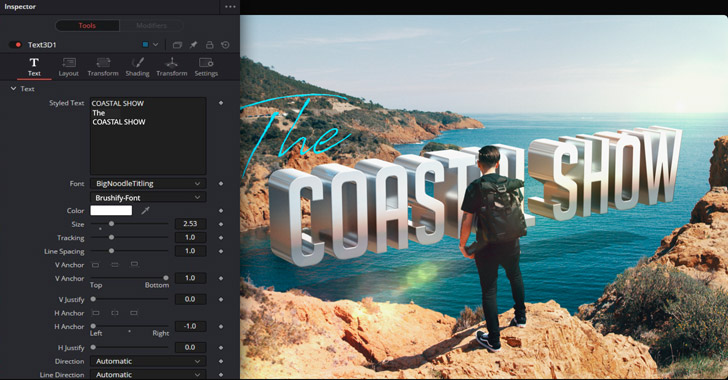Mastering Creativity: An Extensive Guide to Creating Custom Graphics in DaVinci Resolve

Introduction:
Custom graphics are powerful visual elements that add depth, personality, and professionalism to your videos. In DaVinci Resolve, a comprehensive editing and compositing software, creating custom graphics is not only possible but also highly flexible and intuitive. Whether you’re designing logos, overlays, animations, or visual effects, DaVinci Resolve provides the tools and capabilities to bring your creative vision to life. In this extensive guide, we’ll delve deep into the art of creating custom graphics in DaVinci Resolve, equipping you with the knowledge and techniques to elevate your video productions with bespoke visual elements.
Understanding Custom Graphics in DaVinci Resolve:
Custom graphics encompass a wide range of visual elements, including logos, titles, lower thirds, overlays, animations, and visual effects. In DaVinci Resolve, custom graphics can be created using a combination of text tools, shape tools, effects, and animation controls within the Fusion page. Whether you’re designing static graphics or dynamic animations, DaVinci Resolve offers a versatile and powerful environment for graphic creation and customization.
Using DaVinci Resolve for Creating Custom Graphics:
Let’s explore the step-by-step process of creating custom graphics in DaVinci Resolve:
- Open the Fusion Page:
- Launch DaVinci Resolve and open your project. Navigate to the Fusion page by clicking on the Fusion tab at the bottom of the interface. Fusion is DaVinci Resolve’s node-based compositing environment, where you’ll create and customize custom graphics.
- Add Nodes:
- Start by adding nodes to the Fusion composition. Depending on the type of graphic you’re creating, you may use text nodes, shape nodes, image nodes, or other types of nodes to build your graphic. Right-click in the node graph and select “Add Tool” to add nodes to the composition.
- Design Graphic Elements:
- Use text nodes to create textual elements such as titles, labels, or annotations. Customize the text properties, including font, size, alignment, color, and spacing, to achieve the desired look.
- Use shape nodes to create geometric elements such as rectangles, circles, or polygons. Adjust the shape properties, including size, position, rotation, and corner radius, to create custom shapes and designs.
- Use image nodes to import and incorporate external images or graphics into your composition. Import images, logos, icons, or illustrations and position them within the composition as needed.
- Apply Effects and Styles:
- Enhance your custom graphics with effects and styles to add visual interest and polish. DaVinci Resolve offers a wide range of built-in effects, such as drop shadows, glows, outlines, gradients, and textures, which you can apply to your graphic elements.
- Experiment with different effects and styles to achieve the desired look and feel for your custom graphics. Combine multiple effects and adjust their parameters to create unique and visually appealing designs.
- Animate Graphic Elements:
- Bring your custom graphics to life with animation. Use keyframes to animate the position, scale, rotation, opacity, and other properties of the graphic elements over time. Create smooth transitions, dynamic movements, and eye-catching effects to engage the viewer.
- Use the animation curve editor to fine-tune the timing and easing of keyframe animations, ensuring that they flow seamlessly with the overall rhythm and pace of your video.
- Composite Graphics:
- Once you’re satisfied with the design and animation of your custom graphics, integrate them into your timeline on the Edit page. Simply drag and drop the Fusion composition containing the graphics onto the timeline to overlay them onto your footage.
- Preview and Fine-Tune:
- Preview the custom graphics in the viewer window to assess their appearance and behavior. Fine-tune the design, effects, and animations as needed to achieve the desired look and feel for your graphics.
- Pay attention to details such as readability, visual hierarchy, and consistency to ensure that your custom graphics complement the content and enhance the overall visual storytelling of your video.
- Export Your Project:
- Finally, render your project to export the final video with the custom graphics included. Navigate to the Deliver page, configure the export settings, and click “Add to Render Queue” to queue the project for rendering. Then, click “Start Render” to export the video with your custom graphics.
Best Practices for Creating Custom Graphics:
To create impactful and visually appealing custom graphics in DaVinci Resolve, consider the following best practices:
- Plan Your Design:
- Before creating custom graphics, plan your design and identify the key elements and visual style you want to achieve. Consider the purpose, audience, and context of your video to inform your design decisions.
- Keep It Simple and Consistent:
- Keep your custom graphics simple, clear, and consistent with the overall aesthetic of your video. Avoid cluttered designs or conflicting visual styles that may distract or confuse the viewer.
- Maintain consistency in typography, color scheme, and graphic elements across all your custom graphics to create a cohesive and unified visual identity.
- Use Visual Hierarchy:
- Use visual hierarchy to prioritize information and guide the viewer’s attention. Use size, color, contrast, and placement to differentiate between primary, secondary, and tertiary elements within your custom graphics.
- Test on Different Devices:
- Test your custom graphics on different devices and screen sizes to ensure compatibility and readability across various platforms. Consider how they will appear on small screens, mobile devices, and large displays to optimize the viewing experience.
- Iterate and Refine:
- Iterate on your designs and solicit feedback from others to refine and improve your custom graphics. Experiment with different layouts, styles, and effects to explore creative possibilities and elevate the visual impact of your graphics.
Conclusion:
Creating custom graphics in DaVinci Resolve is a creative and rewarding process that allows you to enhance your videos with bespoke visual elements. By leveraging the text tools, shape tools, effects, and animation capabilities available in DaVinci Resolve’s Fusion page, you can design and animate custom graphics that captivate your audience and reinforce your message. Whether you’re producing tutorials, presentations, promotional videos, or any other type of content, mastering the art of creating custom graphics in DaVinci Resolve empowers you to elevate the production value of your projects and deliver compelling visual storytelling. Experiment with different techniques, explore creative possibilities, and let your imagination soar as you craft custom graphics that leave a lasting impression on your viewers.







